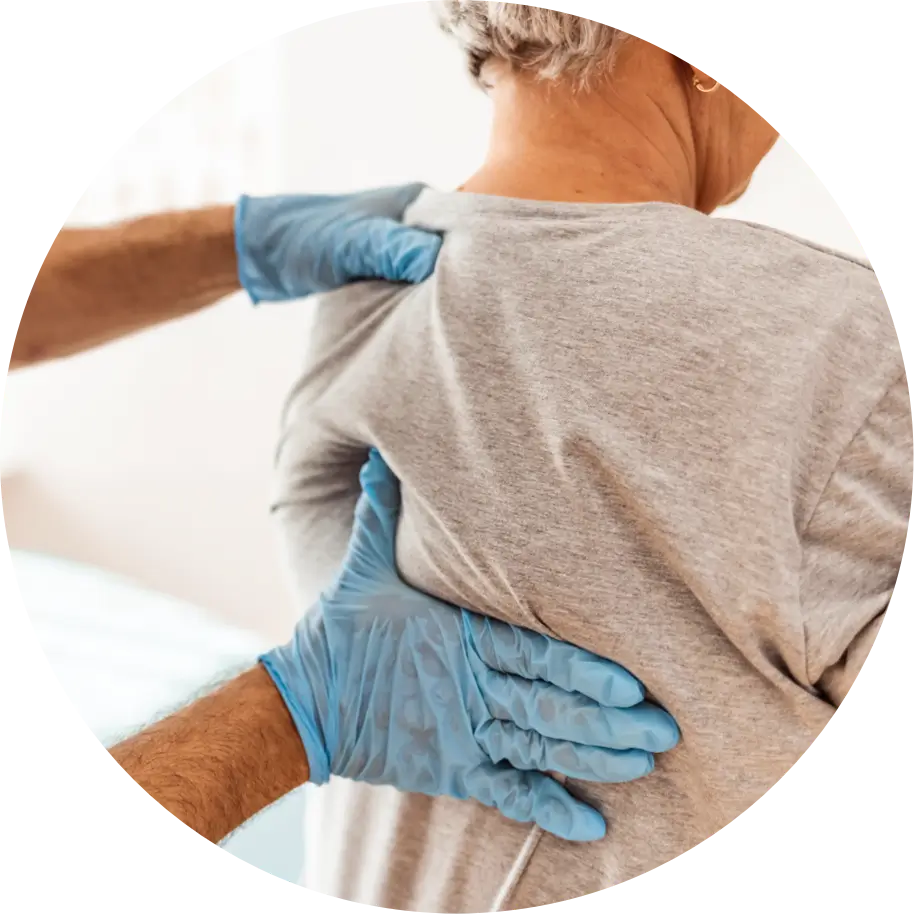At Long Island Spine Rehabilitation Medicine, we treat patients with shoulder pain due to a variety of causes. One of these causes is shoulder subluxation. Our practice is holistic so we offer a large number of therapies, both traditional and complementary, none of them involving surgical procedures.
Our mission is to relieve pain and restore range of motion in patients with shoulder subluxation and other types of musculoskeletal problems. We have an impressive record of successful outcomes without surgery.
Anatomy of the Shoulder
In order to understand shoulder subluxation, it is necessary to understand the anatomy of the shoulder. The shoulder is made up of three bones: the humerus, the large bone of the upper arm, the scapula (shoulder blade), and the clavicle (collarbone). The rounded end of the humerus, the humeral head, fits neatly into the glenoid, the concave portion of the scapula. For this reason, the shoulder is known as a “ball and socket” joint.
What Exactly Is Shoulder Subluxation?
Shoulder subluxation is a partial dislocation of the shoulder in which the rounded upper end of the humerus partially slides in and out of the concave portion of the scapula. To put this in more familiar terms, shoulder subluxation occurs when the ball slips in and out of the socket. If the situation worsens, and the bones are completely separated, the condition is known as shoulder dislocation.
Shoulder subluxation typically occurs when the ligaments of the labrum, the soft tissue that surrounds the socket, become stretched, torn, or detached, making the joint unstable. As this instability occurs, the patient feels sharp pain as their shoulder gives way and the bones slip out of position. In some cases, shoulder subluxation resolves on its own, but on many occasions, it requires medical intervention to stop the pain and prevent complete dislocation.
Why the Shoulder Is Vulnerable to Subluxation
A large and complex joint, the shoulder is the most moveable joint in your body, enabling the arm to lift, rotate, and reach high over your head. The intricate construction of bones, ligaments, and muscles that work together to keep it flexible and provide a wide range of motion, however, can also lead to instability.
Causes of Shoulder Subluxations
The initial cause of a shoulder subluxation may be an injury that occurs:
- From a fall
- In a car accident
- During work involving overhead reaching
- During sports in which overhead motions are frequent,
e.g. tennis, baseball, or lacrosse
- While swinging from rings or bars
- During a particularly difficult or awkward reach upwards
Why Shoulder Subluxations Recur
Unfortunately, once the ligaments, tendons, and muscles surrounding the shoulder become loose or torn, dislocations are more liable to recur. As a result, some patients suffer chronic shoulder instability.
It should be noted that about 20 percent of the population is considered to be hypermobile
(“double-jointed”), meaning they are flexible beyond the usual limits. While these individuals often make wonderful gymnasts and dancers, they may also be more prone to subluxations in the shoulders and elsewhere.
Symptoms of Shoulder Subluxation
Common symptoms of shoulder subluxation include:
- Discomfort and/or pain in the shoulder
- Visible deformity of the shoulder
- Swelling and stiffness at the site
- Sensation of bones in the shoulder moving
- Numbness or tingling (paresthesia) along the arm
- Restricted mobility of the arm and shoulder
- Clicking or catching sensation when moving the arm, especially when reaching up or over the head
- Sensation that the shoulder is “loose” or “just hanging”
If you have any of these symptoms, it’s important to contact one of the highly capable doctors at Long Island Spine Rehabilitation Medicine to have your problem properly diagnosed and treated. Not only do you deserve pain relief, but you want to make sure no further damage occurs.
Diagnosis of a Shoulder Subluxation
As physiatrists, we pride ourselves on our diagnostic accuracy as well as on the broad range of treatments we provide. To correctly diagnose shoulder subluxation, we will perform a careful physical examination and have X-rays taken to determine the precise position of your affected bones.
Depending on individual circumstances, we may also administer an MRI and/or an ultrasound, either of which can provide us with images of soft tissues so we know whether there are tears, ruptures, or other abnormalities in tendons or ligaments in the region.
Nonsurgical Treatment of Shoulder Subluxation
Once we determine that your problem is shoulder subluxation, we will discuss treatment options with you, making recommendations based on the nature of your injury and your personal preferences. Wearing a shoulder brace for support can be very helpful as can one or several of the following treatments:
- Platelet-rich plasma (PRP) to promote healing
- Activity modification to avoid activities that worsen pain
- Acupuncture to reduce pain and inflammation and increase blood flow
- Corticosteroid injections to relieve pain and inflammation directly at the source
- PEMF (Pulsed Electromagnetic Field) therapy, which, in addition to treating pain and inflammation, increases blood flow to your cells to promote more rapid healing
- Personalized physical therapy, including electrical stimulation
to restore range of motion and muscle strength
In almost all cases, shoulder subluxation can be successfully treated without surgery. If your particular situation does require a surgical procedure, we will refer you to one of our talented surgical colleagues.
Contact Our Experienced Shoulder Subluxation Doctors Today
If you are suffering from a strange sensation of laxity in your shoulder as well as pain and restricted mobility, don’t procrastinate. Our goal, like yours, is to make you feel better and move more easily. Contact our physiatrists now to see what a difference dealing with compassionate, skilled professionals can make.
We serve patients with shoulder subluxation and other musculoskeletal problems at 5 locations throughout Long Island – Great Neck, East Meadow, Huntington, and Lawrence.
